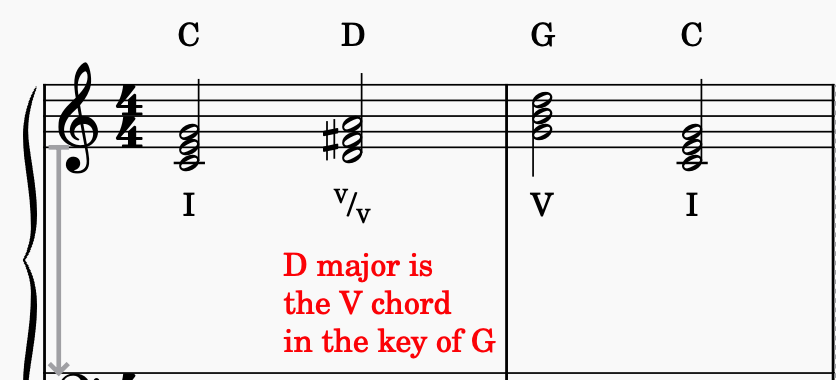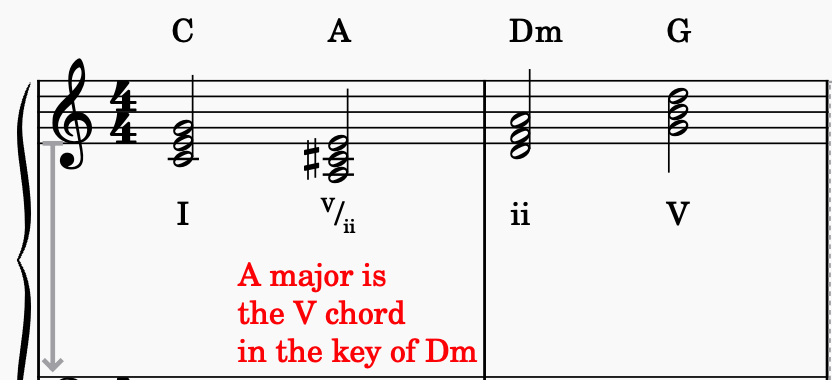Joe Krause Music
Melody
Interval - The distance between two notes (See: Intervals)
Step - A 2nd, or two notes adjacent on the staff
Half Step - A step whose two notes are as close together as possible (ex. G and Ab)
Whole Step - A step whose two notes have one other note between them (ex. G and A)
Skip - a 3rd
Leap - A 4th or larger
Tritone - An augmented 4th or diminished 5th (ex. C and F#)
Scale degrees (Notated with carets: 1̂2̂3̂4̂5̂6̂7̂)
1̂ - Tonic
2̂ - Supertonic
3̂ - Mediant
4̂ - Subdominant
5̂ - Dominant
6̂ - Submediant
7̂ - Leading tone/subtonic
These scale degree names can also be used to refer to the chord built on them, i.e. "the tonic chord" being the I chord.
Chord Tones - Notes contained in the underlying chord
Non-chord Tones - Notes not contained in the underlying chord. Typically, when they appear in a melody, they fall into one of the following use cases:
Passing tone - A note that connects two different chord tones by step
Neighbor tone - A note a step above or below a chord tone that then returns to the same tone.
Appoggiatura - A note on a strong beat that resolves by step, typically approached by leap in the opposite direction.
Escape tone - A note on a weak beat that resolves by skip or leap, approached by step in the opposite direction
Suspension - A note from a previous chord that "hangs over" into the next and resolves by step, typically downward.
Anticipation - A note from the coming chord that "jumps the gun" by sounding before the current chord changes to include it.
Phrase - A musical "sentence", typically 4 or 8 measures long, ending with a cadence.
Motive - A short musical idea, typically 2-8 notes, often repeated or sequenced within a phrase
Sequence - Repetition of an idea but shifted one or more notes up or down
Contour - The overall shape of a melody in terms of intervals
Resolve - To move from a state of tension to relief, dissonance to consonance, or instability to stability
Chromatic - Using accidentals to move by half steps
Harmony
Root - Note on which a chord is named and built.
Root position - A spelling of a chord where the root is the lowest note
Inversion - A spelling of a chord where the root is not the lowest note
Chord types
Triads - 3 distinct notes: the root, the 3rd, and the 5th
Major, minor, diminished, augmented
7th chords - 4 distinct notes: the root, the 3rd, the 5th, and the 7th.
Dominant, Major, minor, minor-major, diminished, half-diminished (Link)
Roman Numerals - Indicate a chord built on a certain scale degree. Capital for major, lowercase for minor, b or # indicate the root is lowered or raised. Inversions are notated with intervals above the bass: I6 for 3rd on bottom (1st inversion) and I64 for 5th on bottom (2nd inversion)
Example in the key of C:

Cadence - A specific chord sequence at the end of a phrase
Authentic cadence - V -> I or i
Perfect Authentic Cadence - Both the V and I chord are in root position, and the melody moves by step to 1̂
Imperfect Authentic Cadence - Either of the conditions for a PAC are not met.
Half Cadence - Anything -> V
Phrygian Half Cadence - iv6 -> V specifically
Plagal Cadence - IV or iv -> I or iv
Secondary Dominant - A V chord borrowed from another key.
Examples in the key of C:
 The D major chord isn't found natively in the key of C, but it is the V chord of the key of G. Here it's borrowed to intensify the movement to G before finally resolving back to C. Notated I, V/V, V, I, because D is acting as the V chord of the V chord, hence secondary dominant.
The D major chord isn't found natively in the key of C, but it is the V chord of the key of G. Here it's borrowed to intensify the movement to G before finally resolving back to C. Notated I, V/V, V, I, because D is acting as the V chord of the V chord, hence secondary dominant.
 Another example would be C, A, Dm, G, where A is the V chord of the ii chord, Dm.
Another example would be C, A, Dm, G, where A is the V chord of the ii chord, Dm.
I, V/ii, ii, V
Modulation - Transitioning from one key to another, often mid-phrase
Parallel keys - Major and minor keys starting on the same note
Relative keys - Major and minor keys sharing the same key signature
Mode Mixture - The use of chords from another mode starting on the same note. (Mainly, using chords from a parallel key, such as using chords from Cm in C or vice versa)
Picardy 3rd - Occurs when a passage or piece otherwise in a minor key ends with a Major I chord.
Diatonic - using the notes provided by a key signature (as in, not chromatic—no accidentals)
Tonal/tonality - Refers to a system of music defined by the relationships between scale degrees and chords to a primary note (the tonic or I/i chord), set in a major or minor key with all its implications. Almost all Western music is tonal.
Modal/modality - Refers to a system of music using a primary note but not necessarily including defined chord/scale degree relationships. Typically diatonic, but not limited to Major/minor keys.
Rhythm
Meter - The number and grouping of beats per measure (defined by the top number of the time signature)
Duple meter - 2 beats
Triple meter - 3 beats
Quadruple meter - 4 beats
Compound meter - each beat is divided into 3 smaller beats (6, 9, 12)
Simple meter - division of beats not specified (2, 3, 4)
Downbeat - the first beat of a measure
Upbeat - Context dependent. Can mean
1.) Beats 2 and 4 in quadruple meter, or 2 and 3 in triple meter
2.) Offbeats (ex. halfway between beats 1 and 2)
3.) A pickup, or the beat before a downbeat/beginning of melody
4.) Uplifting and energetic
Subdivision - The division of a beat into smaller note values (ex. a quarter note can be subdivided into 8ths, 16th, or triplets.)
Strong and weak beats - Beats that are more or less emphasized depending on meter. Downbeats are always strong (and beat 3 in quadruple meter), upbeats are weaker and offbeats are weaker still.
Syncopation - Rhythmic emphasis of a weak beat that "covers up" the following stronger beat.
Hemiola - A rhythmic effect caused by grouping 6 beats into 3 groups of 2, when they previously have been 2 groups of 3.
Form and Style
Form - the structure of a piece of music in terms of larger sections
Binary Form - AB, where A and B represent distinct sections with contrasting characteristics
Ternary Form - ABA or ABA'
A' (or any letter ') - Pronounced "A Prime", where a section is clearly the same as a previous A section but altered in some way, especially the ending.
Rondo - A form with a key theme that returns between successive new material (ex. ABACADA)
Style directives - indicate tempo and/or aesthetic characteristics by which a piece or section is to be played.
Tempo, from fastest to slowest, all ranges are relative:
Presto - Rapid (168-200 bpm - beats per minute)
Vivace - Lively, fast (138-168)
Allegro - Cheerful, fast (116-144)
Moderato - Moderately (100-120)
Andante - "Walking", casual (70-100)
Lento - Slow (54-90)
Adagio - Very slow, expressive (48-76)
Largo - Broad, slow (40-60)
Grave - "Grah-vey" Serious, slow, still (<44)
Suffixes can be attached to some of these to modify their meaning
-etto - A little, or somewhat. (ex. Larghetto—a little slow, not as slow as Largo. Allegretto—a little fast, not as fast as Allegro.)
- issimo - Very (ex. Prestissimo—extremely rapid.)
Modifiers:
Non - Not
Con - With
Senza - Without
Più - More
Meno - Less
Molto - Very
Poco - A little
Ma - But
Tanto - So much
Troppo - Too much
Sempre - Always
Simile - In the same way
Subito - Suddenly
Quasi - As if, partially, almost
Mood/aesthetic:
Agitato - Agitated
Animato - Animated, with spirit
Appasionato - Passionately
Cantabile - In a singing style
Giocoso - Merrily
Grazioso - Gracefully
Dolce - Sweetly
Espressivo - Expressively
Leggiero - Lightly, swiftly
Maestoso - Majestically